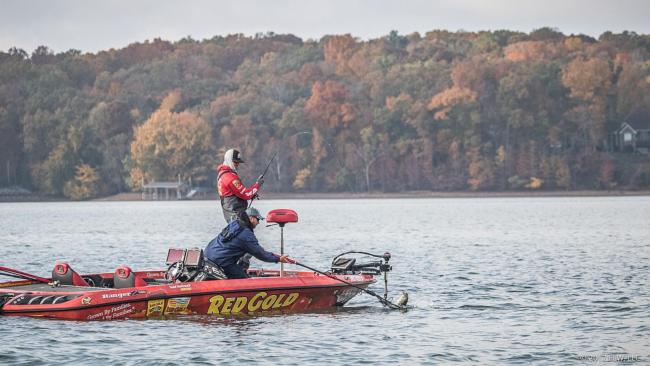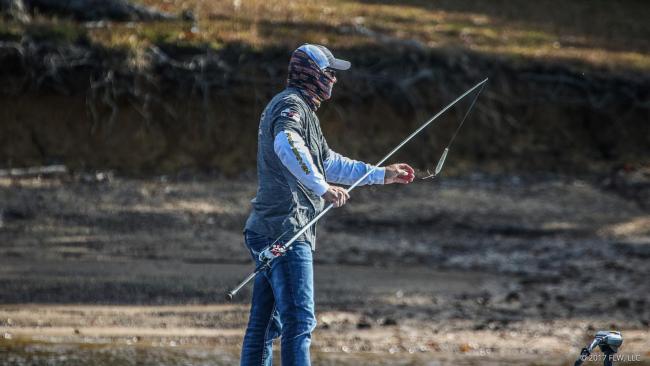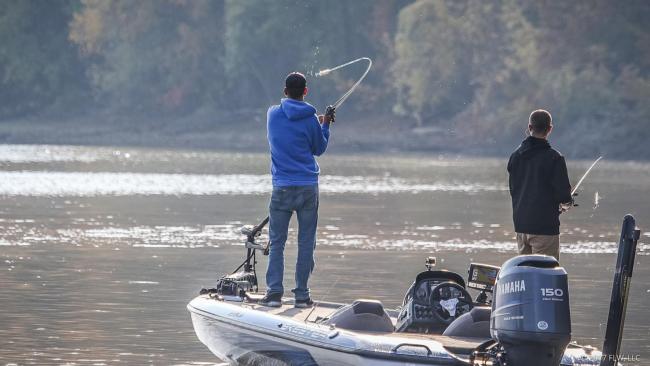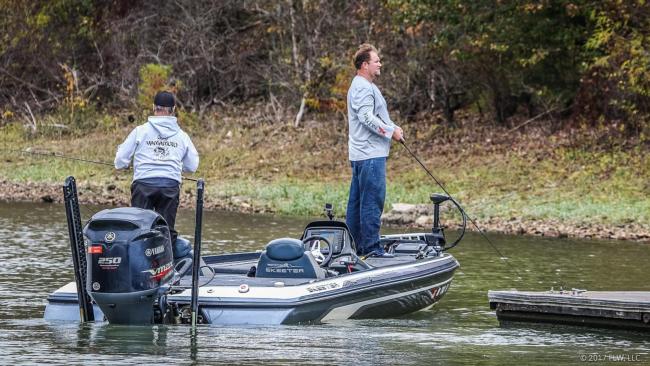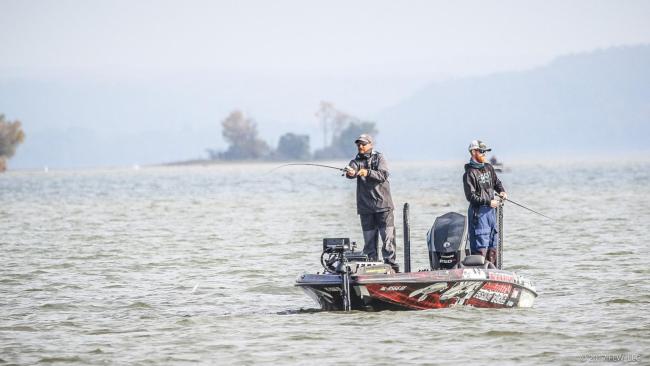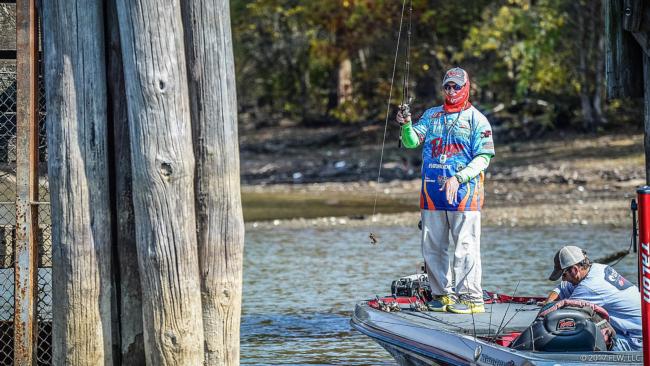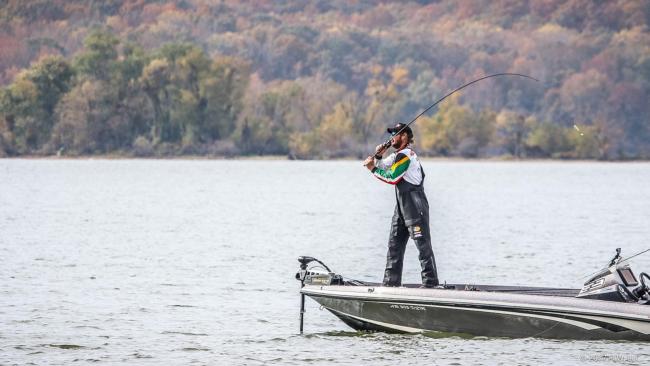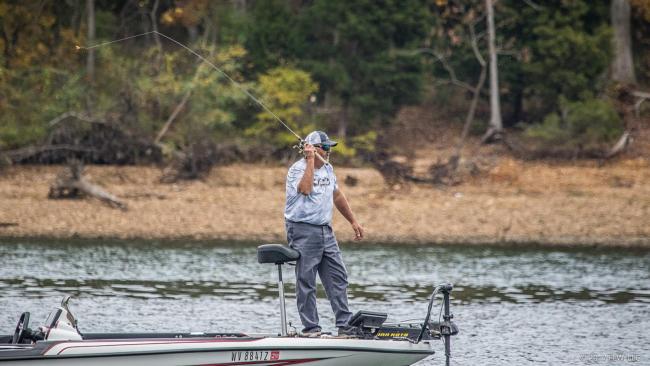Top 10 Patterns from Kentucky Lake
How the best figured them out in the Costa FLW Series Championship
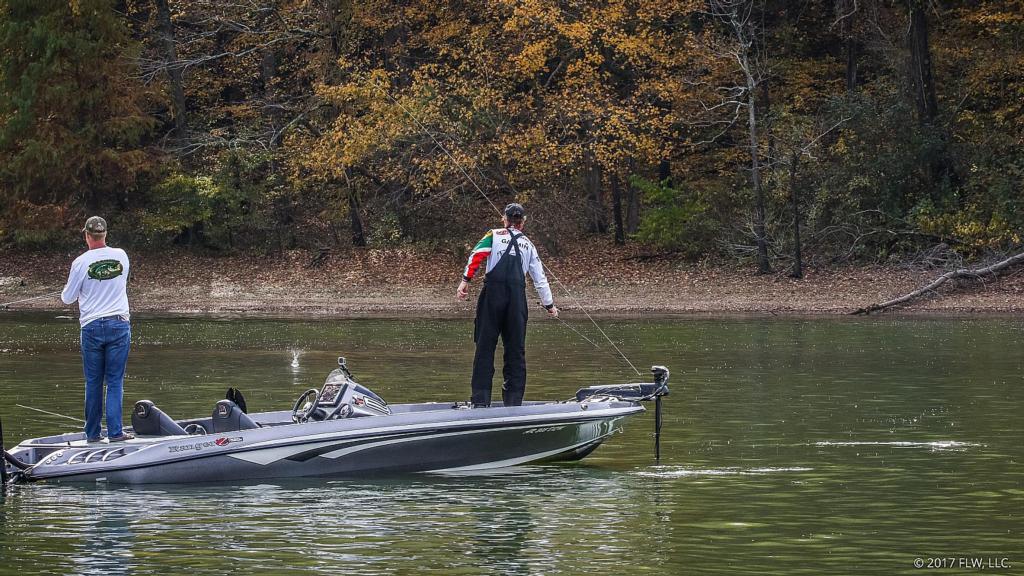
The fishing was downright bad for most in the 2017 Costa FLW Series Championship on Kentucky Lake. Instead of a strong topwater bite or a taste of the winter umbrella rig bite, most of the top finishers – outside of tournament-winner Bradford Beavers – had to scramble around and fish odd patterns or do a little bit of everything. Out of 192 boats, only seven pros limited each of the first two days, and only Beavers managed three limits in a row.
2. The north end produces for Hollowell
Todd Hollowell and his brother, Troy, have a stellar reputation on Kentucky Lake, particularly when the offshore ledge-fishing bite isn’t in full swing. This week, Hollowell scratched out nine quality fish over the first two days, but could only land two big ones on the final day for a 37-pound, 7-ounce total.
“I avoided the south end of the lake,” he says. “I have a lot of history on the south end of the lake, but I felt like all of the fishing pressure would take its toll, and I feel like the numbers on this lake are way down. I didn’t want to get into a situation where I ran 10 or 15 miles south and there were two boats on the place I wanted to fish.”
Hollowell ended up fishing north all the way to the dam. Fishing a combo of shallow bars (2 to 5 feet deep) with topwaters and ledges and creek channel drops (15 to 25 feet deep) with an umbrella rig, single swimbait and a Carolina rig, Hollowell was able to target a handful of places that he had all to himself. For topwaters he threw a popper, a River2Sea Whopper Plopper and a Heddon Super Spook, all on braid with a new 7-foot, 3-inch fiberglass rod called the Bad Dude that he designed for Elite Rods.
“It [the two-part pattern] made it really hard to run a milk run and get my timing down because they were all 13 or 14 miles apart. I feel like I only started to get my timing down today [Saturday],” says the Kentucky Lake veteran. “I thought that deep-and-shallow combo was the way to win this event. The topwater fish I was catching were all 4-plus, but I really didn’t think I could get more than a couple bites a day doing it. But if I could mix in a few keepers a day to go with those big fish I thought 14 or 15 pounds a day would give you a chance. I just didn’t find enough stuff. I found enough to squeak into the top 10, but not enough for today.”
3. Stoafer goes way south
Larry Stoafer and Chad Foster both stretched Kentucky Lake to the limits, running way south past New Johnsonville and fishing past the US-412 bridge in Linden, Tenn. Stoafer limited each of the first two days, but could only manage one fish on the final day for a 34-13 total.
Essentially fishing the Tennessee River, Stoafer tossed a bone-colored Reaction Innovations Vixen when it was windy and swapped to a Keitech 3.8 Swing Impact Fat swimbait in sexy shad rigged on a 1/4-ounce Buckeye Lures J-Will jighead when it was calm. He targeted shallow bars and the mouths of creeks that came off the main river, running 15 or more spots each day to catch his fish.
“My fourth or fifth cast today [Saturday] I had a 4-pounder porpoise me twice and never get hooked up. I thought it was gonna be on. The wind was right and everything, but it never got good,” says Stoafer, who decided to go south after a brutal practice. “It was the worst practice I’ve ever had in tournament fishing. I wanted to fish up there [the upper end of the lake]. My gut told me it was where I could get away, so I did a little soul searching and trusted my instincts and went up there.”
Though he fell short of a win, burning 37-plus gallons of gas a day paid off with $23,500 and his first Forrest Wood Cup qualification.
4. Fox hammers on day two
Tim Fox came into the tournament with little experience on Kentucky Lake but plenty of advice from good friend and fellow competitor David Lee. Lee ended up blanking both days, but Fox caught three on day one and backed it up with an 18-6 bag on day two to make the cut.
“Late yesterday [Friday] afternoon I had two fish, and I had run out of stuff to do,” says Fox. “I saw a windblown shallow point, and I went there for the last hour. I caught four keepers in four casts, and I culled. I weighed in my 18 pounds from that spot.”
Fox’s magic point was nearby takeoff in Big Sandy Creek, but he fished plenty of shallow bars to the south as well. He says he caught 80 percent of his fish on an Evergreen Shower Blows 125 in bone color and the rest on a 1/2-ounce Z-Man/Evergreen Jack Hammer vibrating jig with a white Lake Fork Boot Tail Live Magic Shad trailer.
Fox crossed his fingers for more success on day three, but he arrived at his key point to different conditions. The wind had shifted overnight, and the mudline he keyed on was gone. The fish were, too.
5. Foster runs out of gas
Just like Stoafer, Chad Foster headed way south of New Johnsonville for his fish. He caught enough for the lead after day two, but zeroed on the final day and ran out of gas on the way back to top it off. Nonetheless, he still made the Forrest Wood Cup in his first full year fishing the Costa FLW Series.
“The whole deal for fishing these in general was to make the Cup,” says Foster. “That’s what I wanted to do. All I wanted to do was to fish in August and go catch bass in the Forrest Wood Cup.”
Foster essentially fished the same game plan as Stoafer, hitting mouths of creeks and little drains off the Tennessee River. The best spots had both gizzard shad and wood cover around them.
“In practice I wanted to find something around Paris, because I know how the north wind can turn this lake up really fast,” says Foster. “All the first day of practice I looked for that, and I caught three keepers all day. I enjoy river fishing, so on day two I put in at new Johnsonville and I went even farther south, and I started getting bit. The farther I’d go the more I kept getting bit.”
When it was cold in practice Foster found his fish with a YUM YUMBrella Flash Mob with the blades removed. He rigged it with Bass Pro Shops Speed Shad swimbaits and Outkast Tackle Goldeneye Swimbait Jigheads. With warmer conditions in the tournament he fished a bit shallower and primarily tossed a bone-colored Heddon Saltwater Super Spook.
6. Clear water is the deal for Soukup
Rolling in to Kentucky Lake for the first time from Oklahoma, John Soukup fished a diverse pattern that produced really well on the first two days.
Fishing around Big Sandy, he targeted coves with the clearest water he could find, catching the fish with a vibrating jig cast almost on the bank as well as a walking bait. Additionally, fishing an umbrella rig on one offshore spot provided him with a keeper each of the first two days.
“There were three or four coves, and then I found three or four rock piles,” says Soukup. “Most of my fish were coming off specific spots, but I didn’t really know that until I fished them. I had about a mile section I fished that produced.”
His water was clear the first day, but it turned dingy with the rain on day two. Even so, he still managed to catch a limit and did damage in the afternoon on the vibrating jig that day. His water was clearer than ever on the final day, but he could never make anything happen despite getting exactly the conditions he was looking for.
7. Big day one carries Thrift
Bryan Thrift has smashed more than 27 pounds twice on the Tennessee River – once in 2015 in the Costa FLW Series on Lake Guntersville when an umbrella rig delivered him 27-15, and this week on Kentucky Lake when he hammered 27-8 on a topwater. Unfortunately for Thrift, his big start was more magic than pattern, and he caught two more keepers on day two and zero on day three.
Thrift caught ’em on day one throwing a topwater over shallow bars with stumps, but that pattern fizzled at light speed on the following days.
“I wasn’t on anything. That’s why it didn’t happen,” says Thrift. “I knew the first day that was a miracle bag. It was a product of desperation. I knew I wasn’t on anything, and I knew they catch big ones on topwater, and I’m hard-headed and threw it all day and got five good bites.”
He chalked up one on a shaky head and one on a buzzbait on day two, and went for broke again with the topwater on the final day.
8. Abram flips for it
Slinging a homemade jig and a barely legal-sized Reaction Innovations Vixen, Jason Abram headed down around New Johnsonville every day and was very successful until the brutal final day.
“I was fishing vertical structure,” says Abram. “If it was a pole or a pylon or a tree or anything, I was flipping it. I think the cold weather pushed them around, but they didn’t move out; they just moved down on the vertical stuff.”
Abram fished within a radius of a few miles of the bridge at New Johnsonville and had about eight stops that he ran over and over. He culled each of the first two days fishing the Vixen on riprap in between his flipping targets.
“I’ve never been to Kentucky Lake this time of year, and it really shocked me how different it fishes,” says Abram, who has fished the FLW Tour a lot over the years. “It’s a lot more my style. They can bring it here in the fall anytime. I like tough, grinding tournaments. I don’t like ledge fishing. I like getting on a pattern and just running the lake.”
9. Matthee succeeds in the U.S.
Topping the International Division, Michael Matthee hails from South Africa and had never fished in the United States before dropping down on Kentucky Lake for the Costa FLW Series Championship.
After only three days of practice, Matthee settled on fishing south of Paris.
“I tried to look for deep and shallow water, a combination of the two,” says Matthee. “If my boat was in 10 feet and I was throwing up into 3 I was happy. And if I found a bank with chunk rock that was good.”
On flatter banks he tossed a bone-colored Heddon Super Spook Jr., and he relied on an umbrella rig with 1/8-ounce heads and 3-inch swimbaits on the steeper banks. All week, Matthee deliberately fished his topwater slowly with lots of pauses and avoided the crowded bars, instead focusing on the banks.
“I had four [keepers] and four the first two days, and I caught every one of those fish before nine,” says Matthee, who only managed one keeper on the fog-shortened final day. “Today [Saturday] we left at nine.”
10. Chapman does it again
Bill Chapman is a certifiable hammer, and his laid-back style has earned him 23 top-10 finishes over the years and qualified him for the Forrest Wood Cup in two of the last three seasons.
“I’m a shallow-water fisherman. I go as shallow as I can go,” says Chapman. “In practice I came down before the cutoff and found two areas with shallow fish I was confident in, but the problem was one was 40 miles one way and one was 20 miles the other way.”
Chapman chose the close one, and ran north to Blood River each day. He caught them all day the first day, but his second day was cut short when muddy water rolled into the creek and stifled his bite. The third day was simply a wash.
The West Virginia pro mostly used two green pumpkin-orange jigs – a War Eagle Heavy Finesse Jig and an Eakins jig – with Zoom Super Chunk Jr. trailers. He fished docks, some shallow rock piles in about 2 feet of water, as well as a sharp drop on the end of one sandbar. That particular sand drop produced more than 30 fish through the course of the event, but he never replicated the size he caught in practice.
